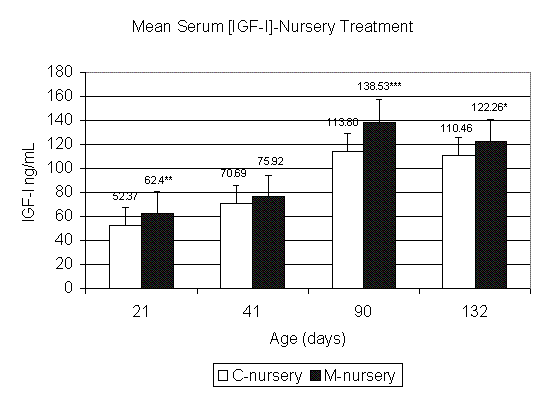
Purdue University 1999 Swine Day Report
T.E. Weber, B.T. Richert, and A.P. Schinckel
Department of Animal Sciences
It has long been known that management practices such as genetic selection, all-in/all-out (AIAO), segregated early weaning (SEW), and feeding diets containing antimicrobials have the potential to increase the efficiency of lean pork production. However, the physiological reasons for this increase in efficiency have yet to be fully discovered. It is common knowledge that pigs subjected to pathogens and other stressors do not reach their genetic lean growth potential. Possible blood-borne markers for lean growth potential and immune system activation include insulin-like growth factor-I (IGF-I) and a1-acid glycoprotein (AGP).
IGF-I is a protein produced by several tissues that mediates many of the effects of growth hormone, such as the stimulation of lean tissue growth and the prevention of lean tissue breakdown. Circulating levels of IGF-I are sensitive to the nutritional and energy status of the animal (Brameld et al., 1996; Weller et al., 1994). The serum concentrations of IGF-I also reflect the health status of an animal. Experimental data demonstrate that an acute phase response (fever, lethargy, anorexia) due to endotoxin injection and parasite infestation includes a sharp decrease in circulating IGF-I levels (Fan et al., 1995; Prickett et al., 1992). The feeding of diets containing subtherapeutic levels of antimicrobials to pigs has been shown to increase serum IGF-I concentrations, along with average daily gain and feed efficiency in young pigs (Hathaway et al., 1996). The results of these experiments suggest that if the pathogen and parasite load on animals is reduced through such practices as AIAO, SEW, and feeding antimicrobials, increased serum concentrations of IGF-I can be obtained and therefore more efficient lean tissue growth can be achieved.
AGP is an acute phase protein produced by the liver in response to inflammatory stimuli. AGP has been demonstrated to work in a negative feedback manner upon the immune system, and works to reduce the inflammatory response (Elg et al., 1997). Attempts have been made to determine the health status of pigs through the measurement of serum AGP as well as other acute phase protein concentrations. Itoh et al. (1992) found that serum AGP levels were higher in pigs raised in a conventional herd than pigs raised in an SPF system.
The nursery phase of the experiment was arranged as a 2 x 2 factorial with two levels of genotype and two nursery feeding regimens. PIC x PIC (P) and Dalland x PIC (D) gilts, originating from two different sources, were delivered to the Purdue SEW units when they were an average of 14 days of age. Pigs were then randomly allocated to two different nursery antimicrobial feeding treatments: Denagard-PLUS® followed by 250 g/ton ASP-250 (MED) or non-medicated diets (NM).
At an average age of 49 days, the pigs were randomly assigned by genotype, litter, and weight to either an all-in/all-out (AIAO) or a continuous flow (CF) finisher. The AIAO finisher had been emptied of all pigs, pens washed, and disinfected prior to moving in the trial pigs. In comparison, pigs allotted to CF were moved into a continuous flow finisher in which every third pen consisted of older pigs. The pigs were further allocated to two different grower-finisher antimicrobial diet treatments: grower phase diets containing 100 g/ton Aureomycin followed by finishing phase diets containing 50 g/ton Aureomycin (FMED), or non-medicated diets in both the grower and finisher phases (FNM). Thus the grower-finisher stage of the experiment was arranged as a 2 x 2 x 2 x 2 factorial with two levels each for genotype, environment, nursery dietary antimicrobial treatment, and grow-finish dietary antimicrobial treatment.
Serum samples were harvested from pigs at 21, 41, 90, and 132 days of age, with samples being drawn from the same pigs at all four time points. Serum concentrations of IGF-I were determined using a previously validated double antibody radioimmunoassay procedure (Taylor, 1994). Concentrations of serum AGP were analyzed by commercially available single radial immunodiffusion test plates. Serum antibodies to porcine reproductive and respiratory syndrome (PRRS) and Mycoplasma hyopneumoniae (MYCO) were determined through the use of enzyme linked immunosorbent assays performed by the serology department of the Purdue Animal Disease Diagnostic Laboratory.
Serum IGF-I: MED pigs had higher mean serum IGF-I levels (P<.05) at 21 days of age than NM pigs (Figure 1). There were no significant differences in mean serum IGF-I levels at 41 days of age (Table 1). At 90 (P<.05) and 132 (P<.01) days of age, P genotype pigs had higher mean serum IGF-I concentrations than D pigs (Table 2). Pigs fed MED in the nursery diets had higher serum IGF-I levels at 90 days (P<.01) than non-medicated pigs (Table 2). There was a trend towards higher serum IGF-I concentrations (P<.10) at 132 days of age in the MED treatment group (Figure 1). At 132 days of age, pigs in the AIAO environment had higher serum IGF-I levels (P<.05) than pigs housed in the CF environment (Figure 2). There was a MED by FMED treatment interaction (P<.05) at 90 days of age (Figure 3). Pigs fed antimicrobials in both the nursery and finisher diets had higher mean serum IGF-I levels at 90 days (P<.05) than pigs fed non-medicated feeds in the nursery and finisher. In addition, pigs fed medicated feeds in both the nursery and finisher had higher serum IGF-I levels (90 days) than pigs fed antimicrobials only in the finisher (P<.01). There was an interaction (P<.05) between genotype and nursery treatment at 132 days of age (Figure 4). D pigs fed non-medicated nursery diets had lower mean serum IGF-I concentrations (P<.05) than D pigs fed medicated diets in the nursery, while P pigs fed control diets and medicated diets in the nursery had similar mean IGF-I levels, and both were greater in mean serum IGF-I levels than were D pigs fed non-medicated nursery diets (P<.05).
Serum AGP: Genotype had an effect upon serum AGP concentrations in 21-day-old pigs (Table 1). D pigs had higher mean serum AGP levels (P<.01) than did P pigs (831 vs. 678 mg/mL). Lower levels of serum AGP (P<.05) were found in 21-day-old pigs fed subtherapeutic levels of antibiotics than in pigs fed non-medicated diets (690 vs. 818 mg/mL). There was a trend (P<.10) towards lower mean serum AGP concentrations in 41-day-old pigs fed MED diets than in pigs fed non-medicated diets (Figure 5). There were no significant differences in mean serum AGP concentrations between treatment groups at 90 and 132 days of age.
PRRS and Mycoplasma hyopneumoniae: The results of the infectious disease serolology show that both PRRS and MYCO were present in both the conventional and AIAO environments. One hundred percent of the pigs in each environment tested positive for serum PRRS antibodies at 90 and 132 days of age. Ninety-five percent of the pigs tested positive for MYCO at 90 days of age with no differences between environments (P=.555). All of the pigs in this study tested positive for MYCO at 132 days of age. Feeding Denagard-PLUSÒ and ASP-250 in the nursery had no effect on the proportion of pigs testing positive for MYCO at 90 days of age (P=.221), nor did feeding aureomycin in the finisher diets (P=.601).
The results of this experiment demonstrate that genotype, environment, and the feeding of subtherapeutic levels of antimicrobials have an effect upon serum concentrations of IGF-I and AGP. As in other studies (Hathaway et al., 1996), feeding diets containing Denagard-PLUS® and 250 g/ton ASP-250 to nursery age pigs from 14 to 49 days of age increased the serum levels of IGF-I. This increase in circulating IGF-I carried over into the grow-finish phase in our study. We have also demonstrated that different genotypes react differently to dietary antimicrobial treatments; at 132 days of age, serum IGF-I levels in pigs of Dalland x PIC origin were more responsive to feeding medications in nursery diets than PIC x PIC pigs (Figure 4). Reducing the pathogen load by practicing all-in/all-out and feeding antimicrobials has the potential to increase serum IGF-I levels as shown in our data.
The increase in serum IGF-I levels in pigs fed medicated diets in the nursery was inversely related to serum AGP concentrations. The pigs fed medicated diets had significantly greater average daily gains and average daily feed intakes in the nursery as compared to pigs fed non-medicated diets (unpublished data). These pigs also tended to be more feed efficient during the first four weeks in the nursery. Perhaps the increase in serum IGF-I levels and decrease in serum AGP levels is indicative of nutrients being partitioned away from immune response and used instead for lean tissue growth. However, this research is just the beginning of trying to delineate the physiology behind why pigs perform differently under various management schemes. Much more collaborative research must be performed in order to complete the puzzle of the physiological and biochemical variables that control both immunity and growth.
Once we discover all of the pathways that link growth physiology and the immune system, they can be manipulated through the use of management practices, pharmaceuticals, and genetics in order to increase the efficiency of lean pork production. This research demonstrates that different genotypes react differently physiologically to various management practices (e.g., feeding antimicrobials), and that producers must fit the correct genotype to their management system and vice versa. In addition, serum variables such as growth mediating factors and acute phase proteins may be viable options when monitoring the health status of animals within a herd and genotype.
Brameld, J.M., J.L. Atkinson, J.C. Saunders, J.M. Pell, P.J. Buttery, and R.S. Gilmour. 1996. Effects of growth hormone administration on insulin-like growth factor I and growth hormone receptor mRNA expression in porcine liver, skeletal muscle, and adipose tissue. J. Anim. Sci. 74:1832-1841.
Elg, S.A., A.R. Mayer, L.F. Carson, L.B. Twiggs, R.B. Hill, and S. Ramakkrishnan. 1997. Alpha-1 acid glycoprotein is an immunosuppressive factor found in ascites from ovarian carcinoma. Cancer. 80:1448-1456.
Fan, J., D. Char, A.J. Kolaska, W. Pan, S.R. Maitra, C.S. Patlak, Z. Spolarics, M.C. Gelato, and C.H. Lang. 1995. Alterations in hepatic production and peripheral clearance of IGF-I after endotoxin. Am. J. Physiol. 269:E33-E42.
Hathaway, M.R., W.R. Dayton, M.E. White, T.L. Henderson, and T.L. Henderson. 1996. Serum insulin-like growth factor concentrations are increased in pigs fed antimicrobials. J. Anim. Sci. 74:1541-1547.
Itoh, H., K. Tamura, I. Minoru, Y. Motoi, K. Kidoguchi, and Y. Funayama. 1992. The influence of age and health status on the serum alpha1-acid glycoprotein level of conventional and specific pathogen-free pigs. Can. J. Vet. Res. 57:74-78.
Prickett, M.D., A.M. Latimer, R.H. McCusker, G.J. Hausman, and A.K. Prestwood. 1992. Alterations of serum insulin-like growth factor-I and IGF-binding proteins in swine infected with the protozoan parasite sarcocystis miescheriana. Domestic Animal Endocrinology. 9:285-296.
Taylor, J.L 1994. Nutritional regulation of insulin-like growth factor-1 production in streptozotocin-diabetic swine. MS thesis. Purdue University.
Weller, P.A., M.J. Dauncey, P.C. Bates, J.M. Brameld, P.J. Buttery, and R.S. Gilmour. 1994. Regulation of porcine insulin-like growth factor I and growth hormone receptor mRNA expression by energy status. Am. J. Physiology. 29:E776-E785.
Table 1. Effect of diet medication and pig genotype on mean serum IGF-I and a1-acid glycoprotein (AGP) for 21 and 41-day-old pigs.
Genotype:a |
D |
P |
|
|
||
|---|---|---|---|---|---|---|
Treatment:b |
C |
M |
C |
M |
SE |
Significancec |
IGF-I, ng/mL - 21 Days |
49.61 |
57.71 |
55.13 |
67.08 |
4.68 |
TN(P<.05) |
IGF-I, ng/mL - 41 Days |
67.23 |
70.31 |
74.14 |
81.51 |
8.90 |
NS |
|
AGP, mg/mL - 21 Days |
916.67 |
746.07 |
720.67 |
635.33 |
48.97 |
G(P<.01), TN(P<.05) |
|
AGP, mg/mL - 41 Days |
669.33 |
538.67 |
642.67 |
626.67 |
42.21 |
TN(P<.01) |
a Genotype: D=Dalland x PIC, P=PIC x PIC.
b Treatment: C=no antimicrobial in diet, M=antimicrobial in diet
(antimicrobials used were Denagard-PLUS® and ASP-250).
c Significance: TN=dietary treatment in nursery stage, G=genotype.
Table 2. Effect of environment, diet medication, and genotype on mean serum IGF-I for 90 and 132 day old pigs.
Environmenta |
CF |
|
|
|||||||
|---|---|---|---|---|---|---|---|---|---|---|
Genotypeb |
D |
P |
|
|
||||||
Treatmentc |
CC |
CM |
MC |
MM |
CC |
CM |
MC |
MM |
SE |
Significanced |
IGF-I, ng/mL |
|
|
|
|
|
|
|
|
|
|
90 Days |
105.15 |
135.38 |
157.86 |
107.71 |
143.80 |
85.50 |
106.75 |
190.13 |
14.11 |
G**, TN***, TNxTF** |
132 Days |
88.90 |
102.35 |
102.86 |
115.36 |
133.35 |
97.30 |
114.70 |
117.74 |
11.87 |
G***, TN*, GxTN** |
Environmenta |
AIAO |
|
|
|||||||
|---|---|---|---|---|---|---|---|---|---|---|
Genotypeb |
D |
P |
|
|
||||||
Treatmentc |
CC |
CM |
MC |
MM |
CC |
CM |
MC |
MM |
SE |
Significanced |
IGF-I, ng/mL |
|
|
|
|
|
|
|
|
|
|
90 Days |
101.45 |
89.95 |
131.37 |
116.06 |
143.37 |
105.78 |
119.83 |
178.55 |
16.29 |
G**, TN***, TNxTF** |
132 Days |
83.58 |
95.11 |
134.79 |
128.97 |
145.06 |
138.06 |
127.11 |
136.57 |
13.70 |
E**, G***, TN*, GxTN** |
a CF=continuous flow, AIAO=all-in/all-out flow.
b D=Dalland x PIC, P=PIC x PIC.
c CC=non-medicated feeds in nursery and finisher diets,
CM=non-medicated feeds in nursery followed by aureomycin in finisher diets,
MC=Denagard-PLUS® and ASP-250 in nursery diets followed by non-medicated
diets in finisher, MM=Denagard-PLUS® and ASP-250 in nursery diets followed
by aureomycin in finisher diets.
d Significance levels: *P<.10, **P<.05,***P<.01; G=Genotype,
TN=Nursery Treatment, TF=Finisher Treatment, E=Environment, x=interaction.

Figure 1. Serum IGF-I for pigs fed diets containing ASP-250 (M) vs. pigs fed non-medicated diets (C) in the nursery. ***P<.01, **P<.05, *P<.10.
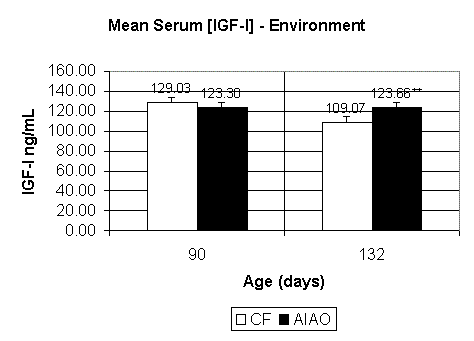
Figure 2. Serum IGF-I, environment comparison. CF=Continuous Flow, AIAO=All-in/All-out. ** P<.05.
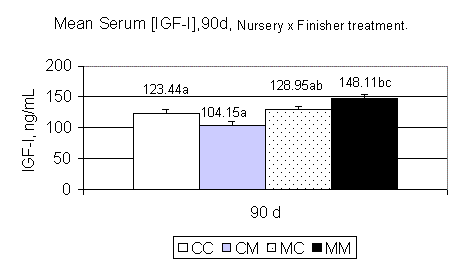
Figure 3. Serum IGF-I concentrations in 90-day-old pigs. CC=no antimicrobials in nursery or finisher diets. CM=non-medicated nursery diet followed by aureomycin in finisher diets. MC=Denagard-PLUS® and ASP-250 in nursery diets followed by non-medicated finisher diets. MM=Denagard-PLUS® and ASP-250 in nursery diets followed by aureomycin in finisher diets. Means lacking common letters significantly differ (P<.05).
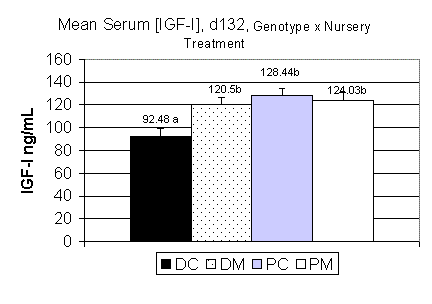
Figure 4. Serum IGF-I concentrations at 132 days. DC=Dalland x PIC pigs fed non-medicated diets in the nursery. DM=Dalland x PIC pigs fed Denagard-PLUS® and ASP-250. PC=PIC x PIC pigs fed non-medicated nursery diets. PM=PIC x PIC pigs fed Denagard-PLUS® and ASP-250 in the nursery. Means lacking common letters significantly differ (P<.05).
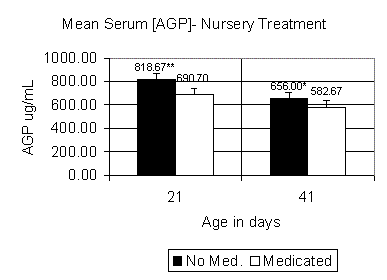
Figure 5. Serum AGP concentrations in 21 and 41-day-old pigs. **P<.05, *P<.10.
Index of 1999 Purdue Swine Day Articles
If you have trouble accessing this page because of a disability, please email anscweb@purdue.edu.